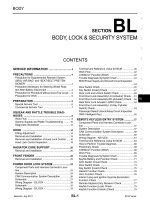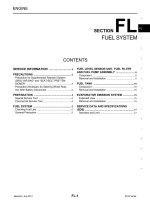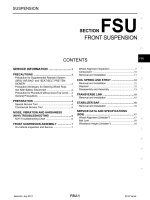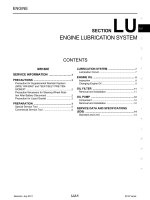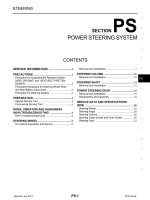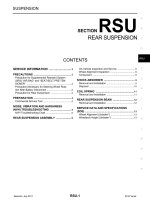BL hệ THỐNG KHÓA cửa, CHỐNG TRỘM NISSAN VERSA HATCH BACK 2012
Bạn đang xem bản rút gọn của tài liệu. Xem và tải ngay bản đầy đủ của tài liệu tại đây (10.29 MB, 281 trang )
BL-1
BODY
C
D
E
F
G
H
J
K
L
M
SECTION BL
A
B
BL
N
O
P
CONTENTS
BODY, LOCK & SECURITY SYSTEM
SERVICE INFORMATION 4
PRECAUTIONS 4
Precaution for Supplemental Restraint System
(SRS) "AIR BAG" and "SEAT BELT PRE-TEN-
SIONER"
4
Precaution Necessary for Steering Wheel Rota-
tion After Battery Disconnect
4
Precaution for Procedure without Cowl Top Cover 5
Precaution for Work 5
PREPARATION 6
Special Service Tool 6
Commercial Service Tool 7
SQUEAK AND RATTLE TROUBLE DIAG-
NOSES
8
Work Flow 8
Generic Squeak and Rattle Troubleshooting 10
Diagnostic Worksheet 12
HOOD 14
Fitting Adjustment 14
Removal and Installation 15
Removal and Installation of Hood Lock Control 16
Hood Lock Control Inspection 18
RADIATOR CORE SUPPORT 20
Removal and Installation 20
FRONT FENDER 22
Removal and Installation 22
POWER DOOR LOCK SYSTEM 23
Component Parts and Harness Connector Loca-
tion
23
System Description 24
CAN Communication System Description 26
Schematic 27
Wiring Diagram - D/LOCK - 28
Schematic 32
Wiring Diagram - D/LOCK - 33
Terminal and Reference Value for BCM 38
Work Flow 42
CONSULT Function (BCM) 42
Trouble Diagnosis Symptom Chart 43
BCM Power Supply and Ground Circuit Inspection
44
Door Switch Check 45
Key Switch (Insert) Check 47
Door Lock and Unlock Switch Check 48
Front Door Lock Assembly LH (Actuator) Check 51
Front Door Lock Assembly RH (Actuator) Check 52
Rear Door Lock Actuator LH/RH Check 53
Front Door Lock Assembly LH (Key Cylinder
Switch) Check
53
Passenger Select Unlock Relay Circuit Inspection
(With Intelligent Key)
55
REMOTE KEYLESS ENTRY SYSTEM 57
Component Parts and Harness Connector Loca-
tion
57
System Description 57
CAN Communication System Description 59
Schematic 60
Wiring Diagram - KEYLES - 61
Terminal and Reference Value for BCM 64
How to Perform Trouble Diagnosis 68
Preliminary Check 68
CONSULT Function (BCM) 68
Work Flow 69
Trouble Diagnosis Symptom Chart 70
Keyfob Battery and Function Check 71
ACC Switch Circuit Check 72
Door Switch Check 73
Key Switch (Insert) Check 75
Hazard Function Check 76
Horn Function Check 76
Interior Lamp and Ignition Keyhole Illumination
Function Check
77
Remote Keyless Entry Receiver Check 77
Keyfob Function (Lock) Check 79
Keyfob Function (Unlock) Check 79
Revision: July 2011 2012 Versa
BL-2
ID Code Entry Procedure 80
Keyfob Battery Replacement 82
Removal and Installation of Remote Keyless Entry
Receiver
82
INTELLIGENT KEY SYSTEM 83
Component Parts and Harness Connector Loca-
tion
83
System Description 85
CAN Communication System Description 92
Schematic 93
Wiring Diagram - I/KEY - 95
Intelligent Key Unit Harness Connector Terminal
Layout
105
Terminal and Reference Value for Intelligent Key
Unit
105
Steering Lock Solenoid Harness Connector Ter-
minal Layout
107
Terminal and Reference Value for Steering Lock
Solenoid
107
Terminal and Reference Value for BCM 108
Trouble Diagnosis Procedure 112
CONSULT Functions (INTELLIGENT KEY) 114
CONSULT Application Item 114
Trouble Diagnosis Symptom Chart 116
CAN Communication System Inspection 122
Power Supply and Ground Circuit Inspection 123
Key Switch (Intelligent Key Unit Input) Check 123
Key Switch (BCM Input) Check 125
Ignition Knob Switch Check 126
Door Switch Check 127
Door Request Switch Check 130
Back Door Request Switch Check 132
Unlock Sensor Check 133
Intelligent Key Warning Buzzer(s) Check 135
Outside Key Antenna (Driver Side and Passenger
Side) Check
136
Outside Key Antenna (Rear Bumper) Check 138
Inside Key Antenna Check 139
Steering Lock Solenoid Check 141
Key Interlock Solenoid (With M/T) Check 143
Ignition Switch Position Check 144
Stop Lamp Switch Check (With CVT or A/T) 144
Stop Lamp Switch Check (With M/T) 145
CVT or A/T Shift Selector (Park Position Switch)
Check
146
"P-SHIFT" Warning Lamp (With CVT or A/T)
Check
148
"LOCK" Warning Lamp (With M/T) Check 148
"KEY" Warning Lamp (RED) Check 149
"KEY" Warning Lamp (GREEN) Check 149
Check Warning Chime in Combination Meter 150
Hazard Function Check 150
Horn Function Check 150
Headlamp Function Check 151
Intelligent Key Battery Replacement 152
Remote Keyless Entry Function 152
Removal and Installation of Intelligent Key Unit 152
DOOR 154
Fitting Adjustment 154
Removal and Installation 157
Back Door Stay Disposal 160
FRONT DOOR LOCK 161
Component Parts Location 161
Removal and Installation 161
REAR DOOR LOCK 164
Component Parts Location 164
Removal and Installation 164
BACK DOOR LOCK 167
Component Parts and Harness Connector Loca-
tion
167
System Description 167
Wiring Diagram - B/DOOR - 168
Terminal and Reference Value for BCM 170
Terminal and Reference Value for Intelligent Key
Unit
174
CONSULT Function (BCM) 176
Work Flow 177
Trouble Diagnosis Chart by Symptom 177
BCM Power Supply and Ground Circuit Inspection
.
177
Check Back Door Opener Switch Circuit (Without
Intelligent Key)
178
Check Back Door Opener Switch Circuit (With In-
telligent Key)
180
Check Back Door Lock Assembly (Actuator) Cir-
cuit
183
Removal and Installation 184
FUEL FILLER LID OPENER 186
Removal and Installation of Fuel Filler Lid Opener . 186
VEHICLE SECURITY (THEFT WARNING)
SYSTEM
187
Component Parts and Harness Connector Loca-
tion
187
System Description 187
CAN Communication System Description 189
Schematic 190
Wiring Diagram - VEHSEC - 191
Terminal and Reference Value for BCM 195
Terminal and Reference Value for Intelligent Key
Unit
199
CONSULT Function (BCM) 201
Trouble Diagnosis 203
Preliminary Check 203
Symptom Chart 205
Diagnosis Procedure 1 205
Diagnosis Procedure 2 208
Diagnosis Procedure 3 209
Diagnosis Procedure 4 209
Diagnosis Procedure 5 209
Diagnosis Procedure 6 209
NATS (Nissan Anti-Theft System) 211
Revision: July 2011 2012 Versa
BL-3
C
D
E
F
G
H
J
K
L
M
A
B
BL
N
O
P
Component Parts and Harness Connector Loca-
tion
211
System Description 211
System Composition 212
ECM Re-communicating Function 212
Wiring Diagram - NATS - 213
Terminal and Reference Value for BCM 214
CONSULT Function 218
Trouble Diagnosis Procedure 219
Trouble Diagnosis 221
Diagnosis Procedure 1 222
Diagnosis Procedure 2 224
Diagnosis Procedure 3 225
Diagnosis Procedure 4 226
Diagnosis Procedure 5 227
Diagnosis Procedure 6 228
How to Replace NATS Antenna Amp 228
BODY REPAIR 229
Body Exterior Paint Color 229
Body Component Parts 230
Corrosion Protection 233
Body Sealing 236
Body Construction 239
Body Alignment 240
Handling Precaution for Plastics 251
Precaution in Repairing High Strength Steel 254
Foam Repair 257
Replacement Operation 259
Revision: July 2011 2012 Versa
BL-4
< SERVICE INFORMATION >
PRECAUTIONS
SERVICE INFORMATION
PRECAUTIONS
Precaution for Supplemental Restraint System (SRS) "AIR BAG" and "SEAT BELT
PRE-TENSIONER"
INFOID:0000000007329960
The Supplemental Restraint System such as “AIR BAG” and “SEAT BELT PRE-TENSIONER”, used along
with a front seat belt, helps to reduce the risk or severity of injury to the driver and front passenger for certain
types of collision. This system includes seat belt switch inputs and dual stage front air bag modules. The SRS
system uses the seat belt switches to determine the front air bag deployment, and may only deploy one front
air bag, depending on the severity of a collision and whether the front occupants are belted or unbelted.
Information necessary to service the system safely is included in the SRS and SB section of this Service Man-
ual.
WARNING:
• To avoid rendering the SRS inoperative, which could increase the risk of personal injury or death in
the event of a collision which would result in air bag inflation, all maintenance must be performed by
an authorized NISSAN/INFINITI dealer.
• Improper maintenance, including incorrect removal and installation of the SRS can lead to personal
injury caused by unintentional activation of the system. For removal of Spiral Cable and Air Bag
Module, see the SRS section.
• Do not use electrical test equipment on any circuit related to the SRS unless instructed to in this
Service Manual. SRS wiring harnesses can be identified by yellow and/or orange harnesses or har-
ness connectors.
PRECAUTIONS WHEN USING POWER TOOLS (AIR OR ELECTRIC) AND HAMMERS
WARNING:
• When working near the Airbag Diagnosis Sensor Unit or other Airbag System sensors with the Igni-
tion ON or engine running, DO NOT use air or electric power tools or strike near the sensor(s) with a
hammer. Heavy vibration could activate the sensor(s) and deploy the air bag(s), possibly causing
serious injury.
• When using air or electric power tools or hammers, always switch the Ignition OFF, disconnect the
battery, and wait at least 3 minutes before performing any service.
Precaution Necessary for Steering Wheel Rotation After Battery Disconnect
INFOID:0000000007329961
NOTE:
• This procedure is applied only to models with Intelligent Key system and NVIS/IVIS (NISSAN/INFINITI
VEHICLE IMMOBILIZER SYSTEM - NATS).
• Remove and install all control units after disconnecting both battery cables with the ignition in the ″LOCK″
position.
• Always use CONSULT to perform self-diagnosis as a part of each function inspection after finishing work. If
DTC is detected, perform trouble diagnosis according to self-diagnostic results.
For models equipped with the Intelligent Key system and NVIS/IVIS, an electrically controlled steering lock
mechanism is adopted on the key cylinder.
For this reason, if the battery is disconnected or if the battery is discharged, the steering wheel will lock and
steering wheel rotation will become impossible.
If steering wheel rotation is required when battery power is interrupted, follow the procedure below before
starting the repair operation.
OPERATION PROCEDURE
1. Connect both battery cables.
NOTE:
Supply power using jumper cables if battery is discharged.
2. Use the Intelligent Key or mechanical key to turn the ignition switch to the ″ACC″ position. At this time, the
steering lock will be released.
3. Disconnect both battery cables. The steering lock will remain released and the steering wheel can be
rotated.
4. Perform the necessary repair operation.
Revision: July 2011 2012 Versa
PRECAUTIONS
BL-5
< SERVICE INFORMATION >
C
D
E
F
G
H
J
K
L
M
A
B
BL
N
O
P
5. When the repair work is completed, return the ignition switch to the ″LOCK″ position before connecting
the battery cables. (At this time, the steering lock mechanism will engage.)
6. Perform a self-diagnosis check of all control units using CONSULT.
Precaution for Procedure without Cowl Top Cover INFOID:0000000007329962
When performing the procedure after removing cowl top cover, cover
the lower end of windshield.
Precaution for Work INFOID:0000000007793371
• When removing or disassembling each component, be careful not to damage or deform it. If a component
may be subject to interference, be sure to protect it with a shop cloth.
• When removing (disengaging) components with a screwdriver or similar tool, be sure to wrap the component
with a shop cloth or vinyl tape to protect it.
• Protect the removed parts with a shop cloth and prevent them from being dropped.
• Replace a deformed or damaged clip.
• If a part is specified as a non-reusable part, always replace it with new one.
• Be sure to tighten bolts and nuts securely to the specified torque.
• After installation is complete, be sure to check that each part works properly.
• Follow the steps below to clean components.
- Water soluble dirt: Dip a soft cloth into lukewarm water, and wring the water out of the cloth to wipe the dirty
area.
Then rub with a soft and dry cloth.
- Oily dirt: Dip a soft cloth into lukewarm water with mild detergent (concentration: within 2 to 3%), and wipe
the dirty area.
Then dip a cloth into fresh water, and wring the water out of the cloth to wipe the detergent off. Then rub with
a soft and dry cloth.
• Do not use organic solvent such as thinner, benzene, alcohol, or gasoline.
• For genuine leather seats, use a genuine leather seat cleaner.
PIIB3706J
Revision: July 2011 2012 Versa
BL-6
< SERVICE INFORMATION >
PREPARATION
PREPARATION
Special Service Tool INFOID:0000000007329964
Tool number
(Kent-Moore No.)
Tool name
Description
—
(J-39570)
Chassis ear
Locating the noise
—
(J-43980)
NISSAN Squeak and Rat-
tle Kit
Repairing the cause of noise
—
(J-43241)
Remote Keyless Entry
Te ster
Used to test key fobs
—
(J-50190)
Signal Tech II
• Activate and display TPMS transmitter
IDs
• Display tire pressure reported by the
TPMS transmitter
• Read TPMS DTCs
• Register TPMS transmitter IDs
• Check Intelligent Key relative signal
strength
• Confirm vehicle Intelligent Key antenna
signal strength
SIIA0993E
SIIA0994E
LEL946A
ALEIA0131ZZ
Revision: July 2011 2012 Versa
PREPARATION
BL-7
< SERVICE INFORMATION >
C
D
E
F
G
H
J
K
L
M
A
B
BL
N
O
P
Commercial Service Tool INFOID:0000000007329965
Tool name Description
Engine ear Locating the noise
SIIA0995E
Revision: July 2011 2012 Versa
BL-8
< SERVICE INFORMATION >
SQUEAK AND RATTLE TROUBLE DIAGNOSES
SQUEAK AND RATTLE TROUBLE DIAGNOSES
Work Flow INFOID:0000000007768830
CUSTOMER INTERVIEW
Interview the customer if possible, to determine the conditions that exist when the noise occurs. Use the Diag-
nostic Worksheet during the interview to document the facts and conditions when the noise occurs and any
customer's comments; refer to BL-12, "
Diagnostic Worksheet". This information is necessary to duplicate the
conditions that exist when the noise occurs.
• The customer may not be able to provide a detailed description or the location of the noise. Attempt to obtain
all the facts and conditions that exist when the noise occurs (or does not occur).
• If there is more than one noise in the vehicle, be sure to diagnose and repair the noise that the customer is
concerned about. This can be accomplished by test driving the vehicle with the customer.
• After identifying the type of noise, isolate the noise in terms of its characteristics. The noise characteristics
are provided so the customer, service adviser and technician are all speaking the same language when
defining the noise.
• Squeak —(Like tennis shoes on a clean floor)
Squeak characteristics include the light contact/fast movement/brought on by road conditions/hard surfaces
= higher pitch noise/softer surfaces = lower pitch noises/edge to surface = chirping.
• Creak—(Like walking on an old wooden floor)
Creak characteristics include firm contact/slow movement/twisting with a rotational movement/pitch depen-
dent on materials/often brought on by activity.
• Rattle—(Like shaking a baby rattle)
Rattle characteristics include the fast repeated contact/vibration or similar movement/loose parts/missing
clip or fastener/incorrect clearance.
• Knock —(Like a knock on a door)
Knock characteristics include hollow sounding/sometimes repeating/often brought on by driver action.
• Tick—(Like a clock second hand)
Tick characteristics include gentle contacting of light materials/loose components/can be caused by driver
action or road conditions.
• Thump—(Heavy, muffled knock noise)
Thump characteristics include softer knock/dead sound often brought on by activity.
• Buzz—(Like a bumble bee)
Buzz characteristics include high frequency rattle/firm contact.
• Often the degree of acceptable noise level will vary depending upon the person. A noise that you may judge
as acceptable may be very irritating to the customer.
• Weather conditions, especially humidity and temperature, may have a great effect on noise level.
DUPLICATE THE NOISE AND TEST DRIVE
If possible, drive the vehicle with the customer until the noise is duplicated. Note any additional information on
the Diagnostic Worksheet regarding the conditions or location of the noise. This information can be used to
duplicate the same conditions when you confirm the repair.
SBT842
Revision: July 2011 2012 Versa
SQUEAK AND RATTLE TROUBLE DIAGNOSES
BL-9
< SERVICE INFORMATION >
C
D
E
F
G
H
J
K
L
M
A
B
BL
N
O
P
If the noise can be duplicated easily during the test drive, to help identify the source of the noise, try to dupli-
cate the noise with the vehicle stopped by doing one or all of the following:
1) Close a door.
2) Tap or push/pull around the area where the noise appears to be coming from.
3) Rev the engine.
4) Use a floor jack to recreate vehicle “twist”.
5) At idle, apply engine load (electrical load, half-clutch on M/T model, drive position on CVT and A/T models).
6) Raise the vehicle on a hoist and hit a tire with a rubber hammer.
• Drive the vehicle and attempt to duplicate the conditions the customer states exist when the noise occurs.
• If it is difficult to duplicate the noise, drive the vehicle slowly on an undulating or rough road to stress the
vehicle body.
CHECK RELATED SERVICE BULLETINS
After verifying the customer concern or symptom, check ASIST for Technical Service Bulletins (TSBs) related
to that concern or symptom.
If a TSB relates to the symptom, follow the procedure to repair the noise.
LOCATE THE NOISE AND IDENTIFY THE ROOT CAUSE
1. Narrow down the noise to a general area. To help pinpoint the source of the noise, use a listening tool
(Chassis Ear: J-39570, Engine Ear: J-39565 and mechanic's stethoscope).
2. Narrow down the noise to a more specific area and identify the cause of the noise by:
• removing the components in the area that you suspect the noise is coming from.
Do not use too much force when removing clips and fasteners, otherwise clips and fasteners can be
broken or lost during the repair, resulting in the creation of new noise.
• tapping or pushing/pulling the component that you suspect is causing the noise.
Do not tap or push/pull the component with excessive force, otherwise the noise will be eliminated only
temporarily.
• feeling for a vibration with your hand by touching the component(s) that you suspect is (are) causing the
noise.
• placing a piece of paper between components that you suspect are causing the noise.
• looking for loose components and contact marks.
Refer to BL-10, "
Generic Squeak and Rattle Troubleshooting".
REPAIR THE CAUSE
• If the cause is a loose component, tighten the component securely.
• If the cause is insufficient clearance between components:
- separate components by repositioning or loosening and retightening the component, if possible.
- insulate components with a suitable insulator such as urethane pads, foam blocks, felt cloth tape or urethane
tape. A NISSAN Squeak and Rattle Kit (J-43980) is available through your authorized NISSAN Parts Depart-
ment.
CAUTION:
Do not use excessive force as many components are constructed of plastic and may be damaged.
Always check with the Parts Department for the latest parts information.
The following materials are contained in the NISSAN Squeak and Rattle Kit (J-43980). Each item can be
ordered separately as needed.
URETHANE PADS [1.5 mm (0.059 in) thick]
Insulates connectors, harness, etc.
76268-9E005: 100×135 mm (3.94×5.31 in)/76884-71L01: 60×85 mm (2.36×3.35 in)/76884-71L02: 15×25
mm (0.59×0.98 in)
INSULATOR (Foam blocks)
Insulates components from contact. Can be used to fill space behind a panel.
73982-9E000: 45 mm (1.77 in) thick, 50×50 mm (1.97×1.97 in)/73982-50Y00: 10 mm (0.39 in) thick,
50×50 mm (1.97×1.97 in)
INSULATOR (Light foam block)
80845-71L00: 30 mm (1.18 in) thick, 30×50 mm (1.18×1.97 in)
FELT CLOTH TAPE
Used to insulate where movement does not occur. Ideal for instrument panel applications.
68370-4B000: 15×25 mm (0.59×0.98 in) pad/68239-13E00: 5 mm (0.20 in) wide tape roll. The following
materials not found in the kit can also be used to repair squeaks and rattles.
UHMW (TEFLON) TAPE
Insulates where slight movement is present. Ideal for instrument panel applications.
SILICONE GREASE
Revision: July 2011 2012 Versa
BL-10
< SERVICE INFORMATION >
SQUEAK AND RATTLE TROUBLE DIAGNOSES
Used instead of UHMW tape that will be visible or not fit.
Note: Will only last a few months.
SILICONE SPRAY
Use when grease cannot be applied.
DUCT TAPE
Use to eliminate movement.
CONFIRM THE REPAIR
Confirm that the cause of a noise is repaired by test driving the vehicle. Operate the vehicle under the same
conditions as when the noise originally occurred. Refer to the notes on the Diagnostic Worksheet.
Generic Squeak and Rattle Troubleshooting INFOID:0000000007768831
Refer to Table of Contents for specific component removal and installation information.
INSTRUMENT PANEL
Most incidents are caused by contact and movement between:
1. The cluster lid A and instrument panel
2. Acrylic lens and combination meter housing
3. Instrument panel to front pillar garnish
4. Instrument panel to windshield
5. Instrument panel pins
6. Wiring harnesses behind the combination meter
7. A/C defroster duct and duct joint
These incidents can usually be located by tapping or moving the components to duplicate the noise or by
pressing on the components while driving to stop the noise. Most of these incidents can be repaired by apply-
ing felt cloth tape or silicone spray (in hard to reach areas). Urethane pads can be used to insulate wiring har-
ness.
CAUTION:
Do not use silicone spray to isolate a squeak or rattle. If you saturate the area with silicone, you will
not be able to recheck the repair.
CENTER CONSOLE
Components to pay attention to include:
1. Shift selector assembly cover to finisher
2. A/C control unit and cluster lid C
3. Wiring harnesses behind audio and A/C control unit
The instrument panel repair and isolation procedures also apply to the center console.
DOORS
Pay attention to the:
1. Finisher and inner panel making a slapping noise
2. Inside handle escutcheon to door finisher
3. Wiring harnesses tapping
4. Door striker out of alignment causing a popping noise on starts and stops
Tapping or moving the components or pressing on them while driving to duplicate the conditions can isolate
many of these incidents. You can usually insulate the areas with felt cloth tape or insulator foam blocks from
the NISSAN Squeak and Rattle Kit (J-43980) to repair the noise.
TRUNK
Trunk noises are often caused by a loose jack or loose items put into the trunk by the owner.
In addition look for:
1. Trunk lid bumpers out of adjustment
2. Trunk lid striker out of adjustment
3. The trunk lid torsion bars knocking together
4. A loose license plate or bracket
Revision: July 2011 2012 Versa
SQUEAK AND RATTLE TROUBLE DIAGNOSES
BL-11
< SERVICE INFORMATION >
C
D
E
F
G
H
J
K
L
M
A
B
BL
N
O
P
Most of these incidents can be repaired by adjusting, securing or insulating the item(s) or component(s) caus-
ing the noise.
SUNROOF/HEADLINING
Noises in the sunroof/headlining area can often be traced to one of the following:
1. Sunroof lid, rail, linkage or seals making a rattle or light knocking noise
2. Sun visor shaft shaking in the holder
3. Front or rear windshield touching headliner and squeaking
Again, pressing on the components to stop the noise while duplicating the conditions can isolate most of these
incidents. Repairs usually consist of insulating with felt cloth tape.
OVERHEAD CONSOLE (FRONT AND REAR)
Overhead console noises are often caused by the console panel clips not being engaged correctly. Most of
these incidents are repaired by pushing up on the console at the clip locations until the clips engage.
In addition look for:
1. Loose harness or harness connectors.
2. Front console map/reading lamp lens loose.
3. Loose screws at console attachment points.
SEATS
When isolating seat noise it's important to note the position the seat is in and the load placed on the seat when
the noise is present. These conditions should be duplicated when verifying and isolating the cause of the
noise.
Cause of seat noise include:
1. Headrest rods and holder
2. A squeak between the seat pad cushion and frame
3. The rear seatback lock and bracket
These noises can be isolated by moving or pressing on the suspected components while duplicating the con-
ditions under which the noise occurs. Most of these incidents can be repaired by repositioning the component
or applying urethane tape to the contact area.
UNDERHOOD
Some interior noise may be caused by components under the hood or on the engine wall. The noise is then
transmitted into the passenger compartment.
Causes of transmitted underhood noise include:
1. Any component installed to the engine wall
2. Components that pass through the engine wall
3. Engine wall mounts and connectors
4. Loose radiator installation pins
5. Hood bumpers out of adjustment
6. Hood striker out of adjustment
These noises can be difficult to isolate since they cannot be reached from the interior of the vehicle. The best
method is to secure, move or insulate one component at a time and test drive the vehicle. Also, engine RPM
or load can be changed to isolate the noise. Repairs can usually be made by moving, adjusting, securing, or
insulating the component causing the noise.
Revision: July 2011 2012 Versa
BL-12
< SERVICE INFORMATION >
SQUEAK AND RATTLE TROUBLE DIAGNOSES
Diagnostic Worksheet
INFOID:0000000007768833
LAIA0072E
Revision: July 2011 2012 Versa
SQUEAK AND RATTLE TROUBLE DIAGNOSES
BL-13
< SERVICE INFORMATION >
C
D
E
F
G
H
J
K
L
M
A
B
BL
N
O
P
LAIA0071E
Revision: July 2011 2012 Versa
BL-14
< SERVICE INFORMATION >
HOOD
HOOD
Fitting Adjustment INFOID:0000000007329969
FRONT END HEIGHT ADJUSTMENT AND LATERAL/LONGITUDINAL CLEARANCE ADJUST-
MENT
1. Remove the front grille. Refer to EI-21.
2. Remove hood lock. Rotate bumper rubber to adjust height until
hood becomes 1.0 to 1.5 mm lower than the fender.
3. Position hood lock and engage striker. Check hood lock and
striker for looseness. Tighten lock bolts to the specified torque.
4. Install the front grille. Refer to EI-21
.
CAUTION:
Adjust the clearance between hood and other parts so that the
dimensional difference left and right is as follows.
SURFACE MISMATCH ADJUSTMENT
1. Remove the front grille. Refer to EI-21.
2. Release hood lock, and adjust surface level difference of hood, fender, and headlamp according to the fit-
ting standard dimension, using RH and LH bumper rubbers.
3. Install and align the hood lock until the center of the striker and the hood lock are vertically aligned.
4. Press the hood lightly with [approx. 29 N (3 kg] of force and adjust A and B as shown.
PIIB6508E
Hood and headlamp (B - B) : Less than 2.0 mm (0.08 in)
Hood and fender (C - C) : Less than 1.5 mm (0.06 in)
Hood and fender (D - D) : Less than 1.5 mm (0.06 in)
PIIB2526J
Hood and front bumper (A - A) : -1.3 - 2.7 mm (-0.05 - 0.11 in)
Hood and fender (D - D) : -0.4 - 1.7 mm (-0.16 - 0.07 in)
Revision: July 2011 2012 Versa
HOOD
BL-15
< SERVICE INFORMATION >
C
D
E
F
G
H
J
K
L
M
A
B
BL
N
O
P
5. After adjustment tighten lock bolts to the specified torque.
6. Install the front grille. Refer to EI-21
.
Removal and Installation INFOID:0000000007329970
HOOD ASSEMBLY
Removal
1. Remove hinge nuts on hood and remove hood assembly.
CAUTION:
Two technicians should be used to avoid damaging the
hood during removal.
1. Hood striker 2. Primary latch 3. Secondary striker
4. Secondary latch
A : 20 mm (0.79 in)
B : 6.8 mm (0.268 in) min.
PIIB5794E
1. Hood hinge 2. Hood stay 3. Radiator core seal rubber
4. Hood assembly 5. Hood insulator 6. Hood stay holder
PIIB2528J
12.7 N·m (1.3 kg-m, 9.4 ft-lb)
PIIB2529J
Revision: July 2011 2012 Versa
BL-16
< SERVICE INFORMATION >
HOOD
Installation
Installation is in the reverse order of removal.
CAUTION:
• Before installing hood hinge, apply anticorrosive agent onto the surfaces that make contact with the
vehicle body.
• After installing, perform hood fitting adjustment. Refer to BL-14, "
Fitting Adjustment".
HOOD HINGE
Removal
1. Remove hood assembly. Refer to BL-15, "Removal and Installation".
2. Remove front fender. Refer to BL-22, "
Removal and Installation".
3. Remove bolts and the hood hinge.
Installation
Installation is in the reverse order of removal.
Removal and Installation of Hood Lock Control INFOID:0000000007329971
REMOVAL
Hood Lock
1. Remove front grille (LH). Refer to EI-21, "Removal and Installation".
2. Remove hood lock bolts.
3. Remove hood lock from hood lock cable.
12.7 N·m (1.3 kg-m, 9.4 ft-lb)
PIIB2530J
1. Hood lock 2. Hood lock cable 3. Hood ledge upper front
4. Clip
PIIB6509E
23.6 N·m (2.4 kg-m, 17 ft-lb)
Revision: July 2011 2012 Versa
HOOD
BL-17
< SERVICE INFORMATION >
C
D
E
F
G
H
J
K
L
M
A
B
BL
N
O
P
Hood Lock Reinforcement
1. Remove front bumper. Refer to EI-15, "Removal and Installation".
2. Remove crash zone sensor. Refer to SRS-43, "
Removal and Installation".
3. Remove bolts, and the hood lock reinforcement.
Hood Lock Cable
1. Remove front grille (LH/RH). Refer to EI-21, "Removal and Installation".
2. Remove fender protector (LH). Refer to EI-24, "
Component".
3. Remove hood lock, and remove hood lock cable from hood lock.
4. Remove radiator core upper support, hood ledge, and then remove hood lock cable.
5. Remove hood opener on bottom left of instrument panel, and
then remove hood lock cable.
6. Remove grommet on lower dashboard, and pull out hood lock
cable from passenger room side.
CAUTION:
While pulling the cable, be careful not to damage (peel)
hood opener cable outer surface on edges of body through
hole.
INSTALLATION
Installation is in the reverse order of removal.
• Perform hood fitting adjustment. Refer to BL-14, "
Fitting Adjustment".
Hood Lock Reinforcement
When installing hood lock reinforcement, loosen hood bolts, and
then tighten bolts in the order as shown.
Hood Lock Cable
1. Pull the hood lock cable through the panel hole to the engine compartment.
CAUTION:
23.6 N·m (2.4 kg-m, 17 ft-lb)
PIIB6511E
LIIA2667E
23.6 N·m (2.4 kg-m, 17 ft-lb)
PIIB6513E
Revision: July 2011 2012 Versa
BL-18
< SERVICE INFORMATION >
HOOD
Be careful not to bend the cable too much, keeping the
radius 100 mm (3.94 in) or more.
2. Check that the cable is not offset from the positioning grommet,
and push the grommet into the panel hole securely.
3. Apply the sealant around the grommet (at * mark).
4. Install cable securely to lock.
5. After installing, check hood lock adjustment and hood opener
operation.
Hood Lock Control Inspection INFOID:0000000007329972
CAUTION:
If the hood lock cable is bent or deformed, replace it.
1. Check that the secondary latch is properly engaged with the secondary striker (B: 6.8 mm (0.268 in) with
hood's own weight.
2. While operating the hood release handle, carefully check that the front end of the hood is raised by
approx. 20 mm (0.79 in). Also check that the hood release handle returns to the original position.
3. Check that the secondary hood release operates at 29.4 N (3.0 kg) or below.
4. Confirm static closing force of the hood is 343 – 441 N·m (35 – 44 kg-m).
PIIB5801E
PIIB6537E
1. Hood striker 2. Primary latch 3. Secondary striker
4. Secondary latch A. 20 mm (0.79 in) B. 6.8 mm (0.268 in)
PIIB5794E
Revision: July 2011 2012 Versa
HOOD
BL-19
< SERVICE INFORMATION >
C
D
E
F
G
H
J
K
L
M
A
B
BL
N
O
P
5. Check the hood lock lubrication condition. If necessary, apply
“body grease” to the points as shown.
PIIB6514E
Revision: July 2011 2012 Versa
BL-20
< SERVICE INFORMATION >
RADIATOR CORE SUPPORT
RADIATOR CORE SUPPORT
Removal and Installation INFOID:0000000007329973
REMOVAL
Radiator Core Support Upper
1. Remove the air duct. Refer to EM-16, "Removal and Installation".
2. Remove the headlamp (LH/RH). Refer to LT-25, "
Removal and Installation".
3. Remove the hood lock assembly, and remove hood lock cable. Refer to BL-16
.
4. Remove the air guide and hood lock cable clip.
5. Remove the washer tank inlet. Refer to WW-25, "
Removal and Installation of Washer Tank".
6. Remove the radiator core support upper.
Radiator Core Support Lower
1. Remove the air duct. Refer to EM-16, "Removal and Installation".
2. Remove the front bumper. Refer to EI-15, "
Removal and Installation".
3. Remove the headlamp (LH/RH). Refer to LT-25, "
Removal and Installation".
4. Remove the hood lock assembly, and remove hood lock cable. Refer to BL-16
.
5. Remove the air guide and hood lock cable mounting clip.
6. Remove the front bumper reinforcement. Refer to EI-15, "
Removal and Installation".
7. Remove the radiator core lower stay.
8. Remove the undercover.
PIIB6515E
1. Radiator core support upper 2. Radiator core support lower 3. Radiator core support lower stay
4. Radiator core support side stay 5. Air guide
24.5 N·m (2.5 kg-m, 18 ft-lb)
Revision: July 2011 2012 Versa
RADIATOR CORE SUPPORT
BL-21
< SERVICE INFORMATION >
C
D
E
F
G
H
J
K
L
M
A
B
BL
N
O
P
9. Remove radiator core support lower side stay.
10. Tie a cord to all radiator core upper supports of the radiator and
condenser.
NOTE:
To prevent the condenser and radiator from being dropped when
the radiator core lower support is removed.
11. Remove the bolts, and lower radiator core lower supports.
12. Remove the radiator core lower supports.
INSTALLATION
Installation is in the reverse order of removal.
55.0 N·m (5.6 kg-m, 41 ft-lb)
PIIB2800J
PIIB2799J
Revision: July 2011 2012 Versa
BL-22
< SERVICE INFORMATION >
FRONT FENDER
FRONT FENDER
Removal and Installation INFOID:0000000007329974
REMOVAL
1. Remove the headlamp assemblies. Refer to LT-25, "Removal and Installation".
2. Remove the cowl top cover (LH/RH). Refer to EI-22, "
Removal and Installation".
3. Remove the front fender protector. Refer to EI-24, "
Component".
4. Remove the bolt and the front fender.
CAUTION:
While removing use a shop cloth to protect the body from damage.
INSTALLATION
Installation is in the reverse order of removal.
CAUTION:
• After installing, apply touch-up paint onto the head of the front fender bolts.
• After installing, check front fender adjustment. Refer to BL-14, "
Fitting Adjustment" and BL-154, "Fit-
ting Adjustment".
1. Front fender 2 Bolt (LH 7 bolts required) (RH 8 bolts
required)
LIIA2657E
Revision: July 2011 2012 Versa
POWER DOOR LOCK SYSTEM
BL-23
< SERVICE INFORMATION >
C
D
E
F
G
H
J
K
L
M
A
B
BL
N
O
P
POWER DOOR LOCK SYSTEM
Component Parts and Harness Connector Location INFOID:0000000007329975
ALKIA1773ZZ
Revision: July 2011 2012 Versa
BL-24
< SERVICE INFORMATION >
POWER DOOR LOCK SYSTEM
System Description
INFOID:0000000007329976
Power is supplied at all times
• through 40A fusible link (letter g, located in the fuse and fusible link box)
• to BCM terminal 70
• through 10A fuse [No. 8, located in the fuse block (J/B)]
• to BCM terminal 57
• through 10A fuse [No. 10, located in the fuse block (J/B)]
• to key switch and key lock solenoid terminal 2 (without Intelligent Key system)
• through 10A fuse [No. 31, located in the fuse block (J/B)]
• to key switch and ignition knob switch terminals 2 and 4 (with Intelligent Key system).
When key switch is ON (key is inserted in ignition key cylinder), power is supplied
• through key switch terminal 1 (without Intelligent Key system) or key switch and ignition knob terminal 1 (with
Intelligent Key system)
• to BCM terminal 37.
Ground is supplied
• to BCM terminal 67
• through body grounds M57 and M61.
LOCK OPERATION
When the door is locked with main power window and door lock/unlock switch, ground is supplied
• to BCM terminal 45
• through main power window and door lock and unlock switch terminals 17 and 18
• through body grounds M57 and M61.
When the door is locked with power window and door lock/unlock switch RH, ground is supplied
• to BCM terminal 45
• through power window and door lock and unlock switch RH terminals 1 and 3
• through body grounds M57 and M61.
When the door is locked with front door lock assembly LH (key cylinder switch), ground is supplied
• to BCM terminal 8
• through front door lock assembly LH (key cylinder switch) terminals 4 and 6
• through body grounds M57 and M61.
UNLOCK OPERATION
When the door is unlocked with main power window and door lock/unlock switch, ground is supplied
• to BCM terminal 46
• through main power window and door lock/unlock switch terminals 6 and 17
• through body grounds M57 and M61.
When the door is unlocked with power window and door lock/unlock switch RH, ground is supplied
• to BCM terminal 46
• through power window and door lock and unlock switch RH terminals 2 and 3
• through body grounds M57 and M61.
When the door is unlocked with front door lock assembly LH (key cylinder switch), ground is supplied
• to BCM terminal 7
• through front door lock assembly LH (key cylinder switch) terminals 4 and 5
• through body grounds M57 and M61.
1. BCM M18, M19, M20
(view with glove box removed)
2. Intelligent Key unit M52
(if equipped)
3. Front door lock assembly LH (key cyl-
inder switch) D14
4. Front door switch LH B8, RH B108 5. Front door lock assembly LH (actuator)
D14
Front door lock assembly RH (actuator)
D114
6. Rear door switch LH B6, RH B116
7. Rear door lock actuator LH D205
RH D305
8. Key switch and ignition knob switch M73
(with A/T or CVT and Intelligent Key)
9. Key switch and ignition knob switch
M73 (with M/T and Intelligent Key)
10. Key switch and key lock solenoid M27
(without Intelligent Key)
11. Main power window and door lock/un-
lock switch D7, D8
Power window and door lock/unlock
switch RH D105
12. Fuse block (view with instrument pan-
el LH removed)
13. Passenger select unlock relay M2
(with Intelligent Key)
14. Back door lock assembly (back door
switch) D405 (view with back door open)
15. Combination meter M24
Revision: July 2011 2012 Versa
POWER DOOR LOCK SYSTEM
BL-25
< SERVICE INFORMATION >
C
D
E
F
G
H
J
K
L
M
A
B
BL
N
O
P
When the front door switch LH is ON (door is OPEN), ground is supplied
• to BCM terminal 47
• through front door switch LH terminal 2
• through front door switch LH case ground.
When the front door switch RH is ON (door is OPEN), ground is supplied
• to BCM terminal 12
• through front door switch RH terminal 2
• through front door switch RH case ground.
When the rear door switch LH is ON (door is OPEN), ground is supplied
• to BCM terminal 48
• through rear door switch LH terminal 1
• through rear door switch LH case ground.
When the rear door switch RH is ON (door is OPEN), ground is supplied
• to BCM terminal 13
• through rear door switch RH terminal 1
• through rear door switch RH case ground.
When the back door lock assembly (back door switch) is ON (back door is OPEN), ground is supplied
• to BCM terminal 43
• through back door lock assembly (back door switch) terminals 3 and 4
• through body grounds B117, B132 and D402.
OUTLINE
Functions available by operating the inside door lock and unlock switches
• Interlocked with the locking operation of door lock and unlock switch, door lock actuators of all doors are
locked.
• Interlocked with the unlocking operation of door lock and unlock switch, door lock actuators of all doors are
unlocked.
Functions available by operating the front door lock assembly LH (key cylinder switch)
• Interlocked with the locking operation of front door lock assembly LH (key cylinder switch), door lock actua-
tors of all doors are locked.
• When front door lock assembly LH (key cylinder switch) is unlocked, front door lock assembly LH (actuator)
is unlocked.
• When front door lock assembly LH (key cylinder switch) is unlocked for the second time within 5 seconds
after the first operation, front door lock assembly RH (actuator), rear door lock actuator LH and rear door
lock actuator RH are unlocked.
Key reminder door system
When door lock and unlock switch is operated to lock doors with ignition key inserted in key cylinder and any
door open, all door lock actuators are locked and then unlocked.
AUTOMATIC DOOR LOCKS (LOCK OPERATION)
The interlock door lock function is the function that locks all doors linked with the vehicle speed.
Vehicle Speed Sensing Auto Door Lock*1
All doors are locked when the vehicle speed reaches 24 km/h (15 MPH) or more.
BCM outputs the lock signal to all door lock actuators when it detects that the ignition switch is turned ON, all
doors are closed and the vehicle speed received from the combination meter via CAN communication
becomes 15 MPH (24 km/h) or more.
If a door is opened and closed at any time during one ignition cycle (OFF → ON), even after initial auto door
lock has taken place, the BCM will relock all doors when the vehicle speed reaches 15 MPH (24 km/h) or more
again.
Setting change of Automatic Door Locks (LOCK) Function
The lock operation setting of the automatic door locks function can be changed.
With CONSULT
The ON/OFF switching of the automatic door locks (LOCK) function and the type selection of the automatic
door locks (LOCK) function can be performed at the WORK SUPPORT setting of CONSULT. Refer to BL-42,
"CONSULT Function (BCM)".
Without CONSULT
The automatic door locks (LOCK) function can be switched ON/OFF by performing the following operation.
1. Close all doors (door switch OFF).
Revision: July 2011 2012 Versa



